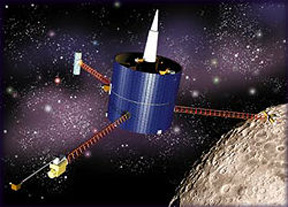Click on image for full size
Courtesy of NASA
Related links:
Lunar Prospector Will Crash Into the Moon! (updated)
News story originally written on August 5, 1999
The Lunar Prosector crashed into the Moon on July 31. No plume of dust was visible from Earth. Scientists will study data taken by special instruments to see if water vapor escaped.
According to scientists, this was the best way to discover water on Earth's only natural satellite. Lunar Prospector was propelled towards a giant crater near the southern pole, and crashed into it at a speed of 3,800 MPH. Scientists hoped that seconds after the collision, a cloud of water vapor would surround the spacecraft. Other scientists, however, say there is no water on the Moon. Instead, the satellite will hit a surface which they say is like concrete.
"We don't believe that crater is paved like a roadway, but we do believe the soil may be chemically very much like concrete," said Von R. Eshleman, a researcher at Stanford University.
Eshleman believes that if there is any water at all, it is locked up in mineral crystals. These crystals would have to be heated to very high temperatures before the water could be taken out. Scientists are hoping that water would be available for a future lunar base on the Moon. The water could be separated into oxygen, which could be used for a breathing gas, and hydrogen, which can be used for fuel.
"I doubt if there will be a flash," David Goldstein, the scientist that first came up with the idea, said. "And the vapor cloud won't be visible."















